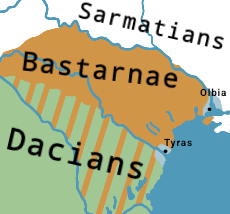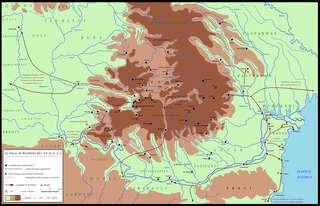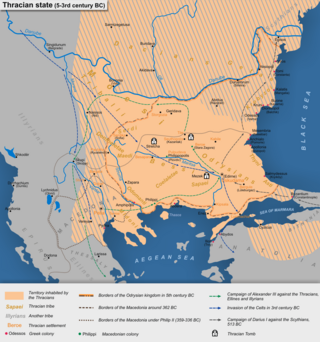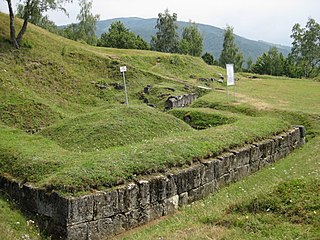
Sarmizegetusa Regia was the capital and the most important military, religious and political centre of the Dacians before the wars with the Roman Empire. Built on top of a 1200 m high mountain, the fortress, consisting of six citadels, was the core of a strategic and defensive system in the Orăștie Mountains.
Dacian is an extinct language generally believed to be a member of the Indo-European language family that was spoken in the ancient region of Dacia.
Kogaionon was the holy mountain of the Geto-Dacians, the place where Zalmoxis stayed in a cave for three years. After his disappearance into Kogaionon, he was considered dead by the Getae but after three years he resurrected and showed himself to the people, who became convinced by his holy preaching when he emerged from Kogaionon.
The Apuli or Biefi were a Dacian tribe centered at the Dacian town Apulon near what is now Alba Iulia in Transylvania, Romania.

Oroles was a Dacian king during the first half of the 2nd century BC.

The Albocenses were a Dacian tribe that inhabited the area of Banat with the towns of Kovin, Trans Tierna, Ad Medias II, Kladovo, Apu, Arcidava, Centum Putea, Ram (Lederata) and Praetorium I. They lived between the Timiş River (Tibiscus) and north of the Saldenses, south of the Biephi. It is believed that the tribe migrated to Spain in Roman times.

Ciaginsi was a Dacian tribe.
Bregedava was a Dacian town.
Danedevae was a Dacian town.
Dausdava was a Dacian town in Moesia between the Danube and the Balkan Mountains, in the region between Nicopolis and Abritus.
Docidava was a Dacian town in north-western Roman Dacia.

Giridava was a Dacian town, situated in Moesia, modern northern Bulgaria.
Itadava was a Dacian town, in the territory of the fortress with unknown name near Burgaraca.
Murideva was a Dacian town in Scythia Minor, not far from Zaldapa.
Perburidava was a Dacian town.

Dacian fortress of Bănița is one of the six Dacian Fortresses of the Orăștie Mountains, in Romania. Together with the other Dacian fortresses in the area, it was designated as an UNESCO World Heritage Site in 1999.

The Costești-Blidaru Dacian fortress is the ruin of a Dacian fortified town in present-day Romania. Located near Costești village in Hunedoara County, it belongs to the Dacian Fortresses of the Orăștie Mountains World Heritage Site. The fortress was built in the 1st century BC, during Burebista's rule, with the purpose of defending the area against the Romans.

The Costești-Cetățuie Dacian fortress was a Dacian fortified town. Located near Costești village, Hunedoara County, Romania, it belongs to the Dacian Fortresses of the Orăștie Mountains World Heritage Site. The fortress was built in the 1st century BC, during Burebista's rule, with the purpose of defending the area against the Romans.
This page is based on this
Wikipedia article Text is available under the
CC BY-SA 4.0 license; additional terms may apply.
Images, videos and audio are available under their respective licenses.








